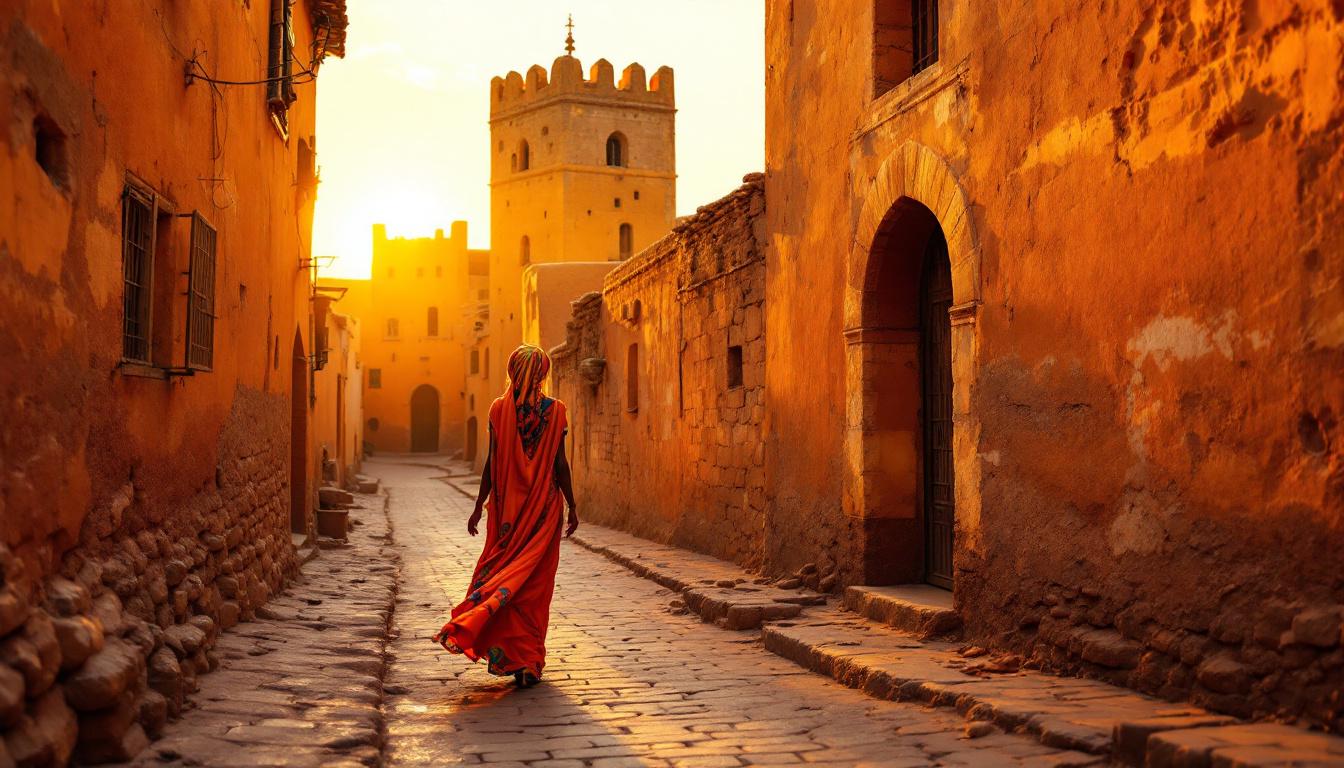Walking through the ancient stone gates of Harar, Ethiopia, feels like stepping through a portal into medieval Marrakech—before the tour buses, before the crowds, before mass tourism transformed authentic Islamic culture into a commodity. This fortified city, smaller than Central Park but denser with history, preserves what North Africa’s famous destinations lost decades ago.
In this compact 1-square-kilometer walled city, 82 mosques and 102 shrines create the spiritual density that once defined pre-tourism Islamic centers. The labyrinthine alleys, numbered at 368, wind through unchanged neighborhoods where Harari families have lived for generations, speaking their ancient dialect and practicing traditions that vanished elsewhere under tourism’s weight.
Here, in Ethiopia’s highlands, survives the authentic Islamic urban experience that drew early travelers to Morocco’s imperial cities—before riads became boutique hotels and medinas became shopping districts for foreign visitors.
The medieval Islamic world that tourism erased elsewhere
Authentic daily rhythms unchanged by commerce
In Harar’s morning markets, Harari women still wear traditional colorful headdresses while selling locally grown coffee and hand-woven textiles. The haggling happens in Harari dialect, not tourist English. No souvenir shops line the ancient walls—just families conducting daily life as their ancestors did for centuries. This is how Marrakech’s Jemaa el-Fnaa operated before it became a UNESCO-listed tourist spectacle.
Sacred spaces serving communities, not cameras
The city’s 82 mosques function as neighborhood centers where locals gather for prayers and community decisions. Unlike Morocco’s famous mosques surrounded by tour groups, Harar’s sacred spaces remain genuinely sacred, welcoming respectful visitors while serving their original spiritual purpose. The Qadiriyya Sufi brotherhood still practices centuries-old rituals in shrines that predate European contact with East Africa.
Traditional crafts that mass production hasn’t touched
Artisans using ancestral techniques
In narrow workshops behind ancient walls, Harari craftspeople create kissa scarves using looms and techniques unchanged since medieval times. These aren’t tourist reproductions—they’re functional textiles made for local families, using cotton grown in surrounding highlands. The coffee ceremony tools, carved from local wood, serve actual social functions rather than tourist demonstrations.
Economic systems serving locals first
Harar’s economy revolves around khat cultivation and coffee production rather than tourism revenue. This means authentic prices: traditional meals cost $2-5, not the $15-25 charged in Marrakech’s tourist restaurants. Local guesthouses, run by families in traditional Harari houses, offer genuine hospitality for $5-15 nightly, compared to Morocco’s $100+ riads marketed to international visitors.
Cultural barriers that naturally limit crowds
Geographic isolation protecting authenticity
Located 525 kilometers from Addis Ababa across highland terrain, Harar requires commitment to reach. No direct international flights deliver package tourists to ancient gates. The 8-hour overland journey through Ethiopian highlands serves as a natural filter, ensuring visitors genuinely want cultural immersion rather than Instagram backgrounds.
Language preservation creating authentic encounters
Conversations happen in Harari, Amharic, and Arabic—not tourist English. This linguistic barrier means deeper engagement with local communities rather than surface-level interactions. Like pre-tourism Morocco, communication requires patience, respect, and often local guides who bridge cultural gaps authentically rather than commercially.
The hyena feeding ritual that symbolizes unchanged traditions
Wildlife interactions rooted in centuries of coexistence
Every evening outside Harar’s walls, wild hyenas approach the city for traditional feeding—a relationship spanning generations of peaceful coexistence. This isn’t a tourist show created for cameras but a genuine cultural practice maintaining balance between human settlement and surrounding wildlife. Such authentic human-animal relationships vanished from North Africa’s tourist centers decades ago.
Spiritual significance beyond spectacle
Local belief systems attribute protective powers to these hyenas, viewing them as guardians of the city’s spiritual integrity. The feeding ritual represents respect for natural cycles that sustained traditional societies before tourism commodified such practices. Participating requires understanding cultural context rather than simply witnessing exotic entertainment.
Planning your journey to authentic Islamic heritage
Visit during Ethiopia’s dry season (October-March) when highland weather suits exploration and cultural festivals provide additional insight into local traditions. July 2025 offers comfortable temperatures around 25-30°C, perfect for walking ancient alleys without tourist season crowds.
Harar represents what we lost when tourism transformed other Islamic heritage cities. Here, authentic culture thrives because geographic barriers and economic independence preserve traditions that elsewhere became performances. This is your chance to experience medieval Islamic civilization as it actually existed—before tour buses discovered it.
Frequently asked questions
How do I reach Harar from major Ethiopian cities?
Regular buses connect Addis Ababa to Harar (8-10 hours) for approximately $30-50. Alternative overland routes through Dire Dawa offer shorter travel times with domestic flight connections, though road transport provides better cultural immersion through highland landscapes.
What cultural protocols should visitors observe?
Respect Islamic customs by dressing modestly, especially near mosques and shrines. Ask permission before photographing people or religious ceremonies. Sacred site etiquette applies universally—approach with genuine interest rather than casual tourism attitudes.
Can tourists participate in traditional activities like khat sessions?
Local families sometimes invite respectful visitors to join coffee ceremonies and cultural discussions. However, khat consumption carries legal and cultural complexities requiring local guidance. Authentic cultural experiences develop through patience and genuine relationship-building rather than tourist expectations.
What’s the best time for experiencing local festivals?
Ethiopian Orthodox holidays and Islamic celebrations provide insights into dual religious traditions coexisting in Harar. Timing visits around Eid celebrations or traditional harvest festivals offers deeper cultural understanding, though requires flexibility with tourist schedules and accommodation availability.
How does Harar’s preservation compare to other UNESCO sites?
While not yet UNESCO-listed, Harar’s preservation exceeds many official World Heritage sites because authentic function continues rather than museum-like conservation. The city remains a living community rather than a tourist destination, ensuring cultural practices serve local needs first.
